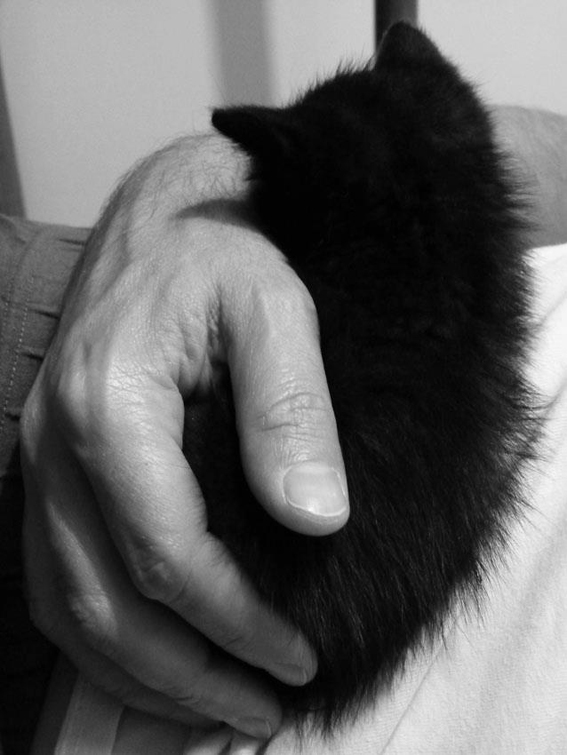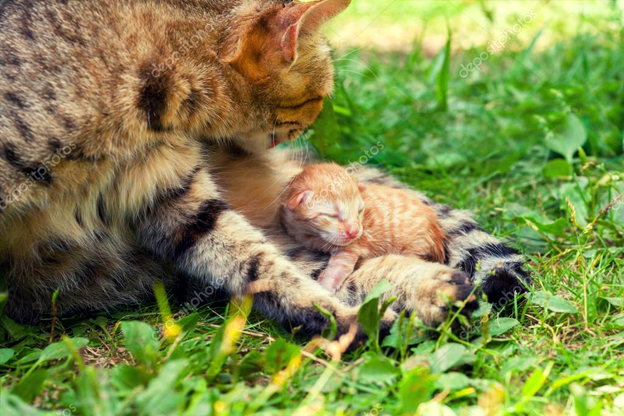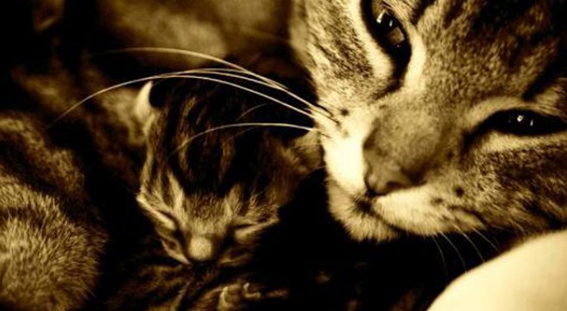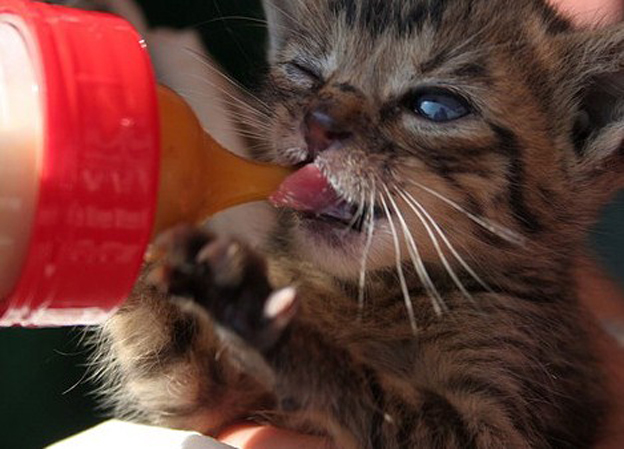HOW TO CARE FOR BABY KITTENS LEFT ORPHAN
- Details
- Category: English
- Hits: 1565

Photo copiright: catadvisor (in the photo Pierino at 4 weeks old)
Practical guide to the rescue of kittens of a few days left without mother cat.
Anyone who has found himself helping orphaned kittens of a few days, knows how difficult and complicated it is to take the place of a mother cat. However good you may be, you will never be sufficiently comparable to the natural competence of a mother cat. In addition, the mother cat transmits colostrum: antibodies within the first 24 hours of birth with the "first milk". If the kittens do not receive these defenses they are exposed to any infection and disease which, for such small kittens, can be fatal.
Taking care and being able to bring such small kittens to weaning requires commitment, knowledge and perseverance and it is of fundamental importance to be supported by a good veterinarian.
Newborn kittens are blind, helpless and helpless. They completely depend on their mum to eat, for cleaning, for thermoregulation and to be able to fulfill their needs. Kittens have their eyes closed for up to 8-10 days. Then they will start opening them. Mother cat will lick their eyes to help them. Absolutely during this period (0-8 days) we must NOT open their eyes so as not to make them blind. After ten days we could help them (if we find that they can't do it on their own) by lightly moistening a cotton ball with warm (not hot) water and wiping it gently over their eyes. NEVER force and always act with extreme delicacy. Make sure you always leave them clean and dry.
If you have any questions, contact your veterinarian immediately.
HOW TO HELP A NEW BORN KITTEN:
Cats are free animals, before taking kittens from the territory, let's make sure of the actual need to put them in safety. It is necessary to ascertain that there is no mother cat nearby and that the kittens are in a situation of real abandonment and danger.
If the mother cat does not come back after 2 hours we have to intervene.

WE ESTIMATE THE AGE OF KITTENS TO KNOW HOW TO BEST HELP THEM:
- 0 to 3 days: they still have the umbilical cord;
- 0 to 10 days: their eyes are still closed;
- 15 days: they already have the incisors erupting and the tip of the canines;
- 28 days or more: they eat alone. In this case, check that they do not have a collar or a tattoo in the auricles. In the first case he may have moved away from home, while in the second case he may belong to a feline colony or to an association.
Now, having ascertained the age of the foundlings, let's see all the indications for bringing our young to weaning age.
PRACTICAL GUIDE FOR THE WEANING OF NEWBORN KITTENS:
1) THE VETERINARY:
Request a home visit from the veterinarian to establish the health of the kittens. I would not take them to the doctor's office to avoid exposing them to viruses, bacteria, infections and stress.
2) Do not try to give him milk immediately, but check that it is not cold (HYPOTHERMIA) and in this case warm it up and dry it immediately
3) IF WE CAN TAKE CARE OF THE KITTENS, we need to buy the specific milk for newborn kittens recommended by our veterinarian, following their instructions and breastfeeding them every 2 or 3 hours. Be followed in this difficult task by an expert and professional figure
4) IF WE CANNOT TAKE CARE OF THE ORPHANED KITTENS, we are looking for a very expert human nurse. To find it, we can turn to animal rights associations that have offices in the area.
Continuing in the article we enter into the detail of the guide:

- PROTECTION AND QUIET:
Find a quiet, safe and secure place to keep and raise newborn kittens. Do not keep them in contact with other animals or other cats, to avoid exposing them to dangers, bacteria and viruses that could be fatal for such small cats.
- THE KENNEL:
Take a small box with high enough edges or a pet carrier with the opening from above to prevent them from going out. Kittens need to stay close, in contact to help maintain a constant body temperature.
Place an absorbent sleeper on the bottom (one side plasticized and the other absorbent). On the absorbent side we will place the kittens that will keep themselves so dry. If we do not have sleepers, we can in an emergency and temporarily cover the bottom with a little absorbent paper or a towel, so that they absorb and do not make the box wet and, above these, a fleece cloth on which to place the kittens. Wool should be avoided because it can cause irritation and in any case fails to adequately warm cats. It is important to keep the "kennel" clean, so when the sleeper (or the cotton cloth and the towel) is dirty or wet, it must be changed.
- SOURCE OF HEAT:
The mother cat warms the little ones with the heat of her own body. Kittens for the first 2 weeks of life cannot regulate their body temperature on their own so it is essential to put a source of heat next to orphaned kittens, without which they would not be able to survive. We can use a hot water bottle (not hot) or, alternatively, fill a plastic bottle with hot water, wrap it with a cotton cloth or a sponge, or, better, put it in a sock (it is essential that the kittens do not stay in direct contact with the hot water bottle or the plastic bottle), and place it in the box, against a wall: the kittens will instinctively approach. However, it is important to change the water in the bottle often because we have to keep it warm: every two or three hours.
There are also heating pads on the market which allow the temperature to be kept constant electrically. They can be bought in pharmacies and health centers. The recommended temperature is 1 or 2. Absolutely forbidden, however, to place them near a radiator or stove: they dry out the air too much and the kittens die. If the heaters are on in the room where we have placed the kittens, it is better to put a humidifier. These precautions are also necessary if we keep the kittens in a heated environment or if we are in the summer.
- ATTENTION TO THE KITTEN'S NAVEL:
The navel must be observed carefully, although it should normally be severed by the mother. However, it may happen that it is truncated excessively short, leaving an opening in the abdomen that leaves a green light for the development of a hernia or umbilical prolapse. In these cases, specific wound management is required, including antibiotic therapy, to prevent omphalitis and septicemia.
- HYPOTHERMIA:
Before feeding the kittens it is essential to make sure that they are not hypothermic: they must be lukewarm, a little warmer than us to the touch. If they are not lukewarm or if they are even cold, first of all we have to heat them because otherwise they cannot digest what they eat. Then rub them with a warm cloth and keep them near a heat source (under the infrared lamp or on the hot water bottle).
- HYPOGLYCEMIA:
it is equally important to assess whether the kittens are in hypoglycemia (lack of glucose in the blood): by approaching the hand to the kitten's head this should start patting with the head (to stimulate the milk to come out) and waving the muzzle in search of the nipple. If, on the other hand, he does not react, before giving him the milk, give him 1 ml of hot (not hot!) Water and sugar every 15 minutes, until he moves his head as explained above.
- HOW TO POWER IT:
We absolutely must not use and administer cow's milk. It is not suitable for kittens. It is low in protein and fat and fails to provide the kitten with proper nutrition. WE USE instead is the powdered milk with colostrum for kittens that we find in the pharmacy. To prepare it, carefully follow the instructions on the box, but only for the first and second feed, asking the veterinarian for confirmation) it may be better to add a little more water than suggested, to give the kittens time to adapt to this new gruel and do not go into diarrhea. Powdered milk should be used as soon as it is prepared and what is left over cannot be used for the next feed.
A kitten must take about 20% of its weight in 24 hours (expressed in grams) Eg a newborn kitten weighs about 100 grams and must take at least 20 ml of milk, distributed over 8-10 meals, therefore about 2 or 3 ml of milk per feed (they must be fed more or less every 3 hours, including night). During the first few days it is best for kittens not to overeat or they may have diarrhea which in such small kittens can be quite dangerous. If the kitten meows insistently after a meal, it may still be hungry. Obviously, as the kittens grow, the quantity of milk must be increased and the number of feedings decreased.
The milk should not be given cold or boiling, but at about 38 degrees (warm-hot in short) to avoid diarrhea or that the cat gets burned.
The ideal is a small bottle (you can easily find it in a pharmacy or pet shop). The hole in the teat must be such that by turning the bottle upside down, without pressing, the milk slowly comes out in drops.
Only as an emergency you can use a 5 ml syringe without a needle and be very careful not to push the milk quickly into the kitten's mouth so as not to make him choke and not let the milk go into his lungs (very dangerous).
The intervention of the veterinarian must be immediate if the kitten breathes badly, eats little or does not eat and continues to meow between meals (puppies sleep between meals).
It is easy to understand if a puppy is hungry: those who are not fed enough meow complaining, swing their heads from side to side and suck what they have within their mouth in the basket).
- NURSING POSITION:
Kittens must be fed by keeping them on their stomach, never tipping them on their stomachs: it could be dangerous.

- WEIGHT OF THE KITTEN
- In the first few days, weigh it after each meal, so you will be sure that it is growing and eating properly
- then weigh him once a day, before feeding and always at the same time. On average it should grow at least 7 grams per day. It is useful to note the weight of the kittens. It is better to weigh them before a feed so as not to have the weights distorted by the milk you have just drunk.
- AFTER MEAL:
For the first two to three weeks IMPORTANT:
a) The puppy must emit the air it has ingested. To make him do the so-called burp, let's place it vertically on your shoulder.
b) Gently massage the anal and genital area of the kittens with a handkerchief or a bit of cotton (better to avoid baby wipes) slightly wet with warm water to simulate the mother's licking, essential to stimulate urination and defecation. Stools should be pale ocher and mushy, but not liquid. If not, it is best to change the milk. It is important to always keep the kittens clean and warm. After feeding, clean the muzzle, nose and eyes, too, gently.
- WEANING
Weaning refers to the passage of the kitten from liquid food (mother's milk) to solid food. Weaning usually begins when the kittens are four weeks old and lasts a few weeks, typically between eight and twelve weeks the kittens should be completely nutritionally independent from their mother's milk.
To switch from the bottle or syringe, used to feed abandoned kittens, to the bowl of milk and then to solid food, we can create baby food by mixing the milk for kittens, initially in larger proportions, to wet food (get advice from the veterinarian) up to obtain a floury mixture. Better not to use cow's milk because some kittens cause stomach upset and diarrhea.
We will gradually decrease the percentage of milk by increasing the portions of food. At six weeks, the kitten should be able to eat moistened food. Between eight and ten weeks we will be able to provide dry food that is not moistened without forgetting to always leave a bowl of fresh water available in the immediate vicinity.
If you liked the article and found it useful, you can share it! Thanks
Catadvisor Team












